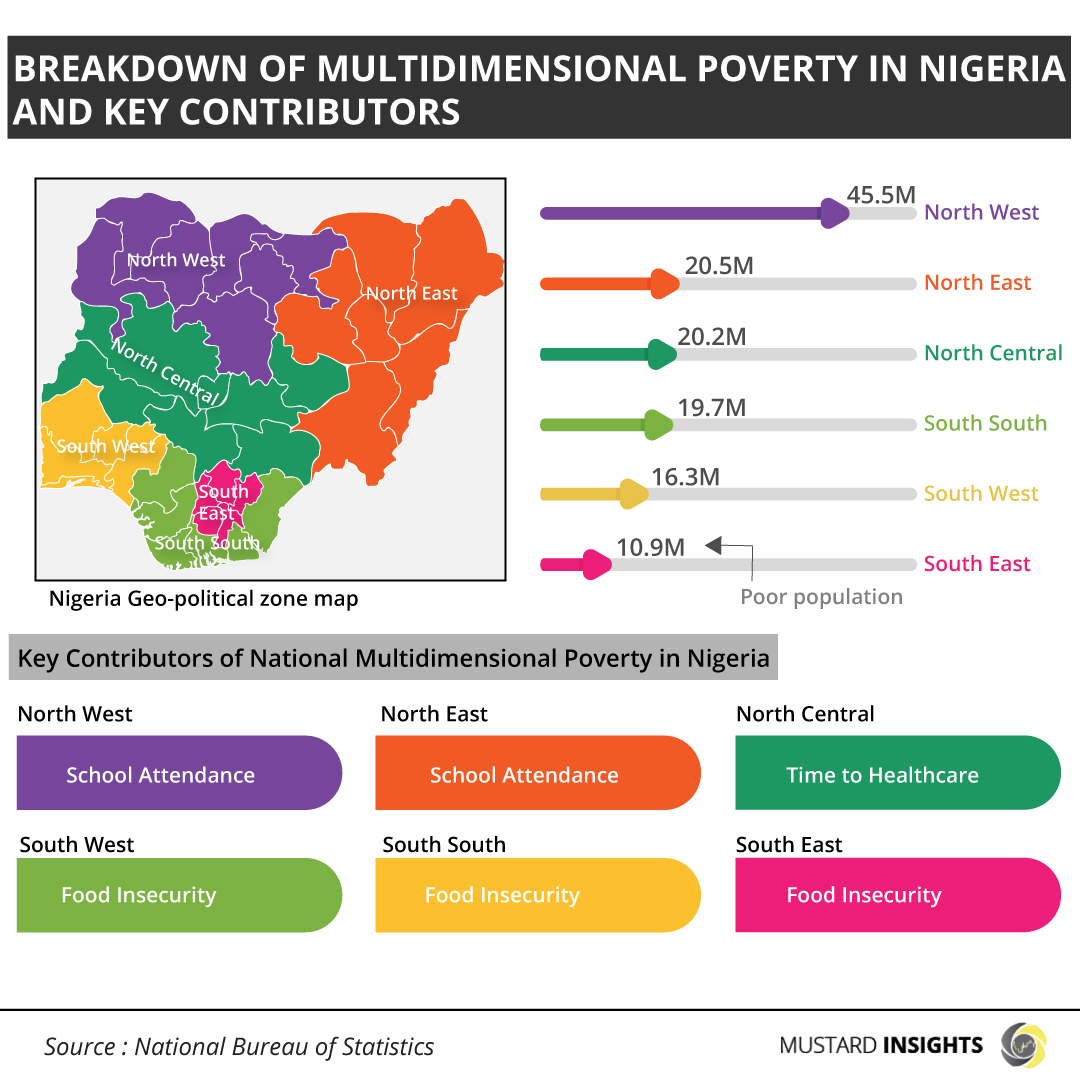Education and Healthcare failure plague the north of Nigeria, as the south suffers widespread food insecurity.

Poverty has seemingly grown exponentially in Nigeria, with more of citizens unable to fulfill basic living provisions. Sluggish economic growth, low human capital, labor market weaknesses, and exposure to shocks are some reasons this poverty, as stated by the World Bank in their 2022 report: "A Better Future for All Nigerians."
According to a report by the Nigerian Bureau of Statistics (NBS), 63% of people living in Nigeria are multidimensionally poor. The Multidimensional Poverty Index (MPI) essentially captures the percentage of households in a country deprived along three dimensions of well-being – monetary poverty, education, and basic infrastructure services, amongst other depravations – to provide a complete picture of poverty. Currently, Nigeria's MPI stands at 0.257, showing that poor people in Nigeria experience just over one-quarter of all possible deprivations. The value ranges from 0 to 1, with 0 reflecting zero poverty and 1, universal poverty and deprivation.
The NBS report also showed that "multidimensional poverty is higher in rural areas, where 72% of people are poor, compared to 42% of people in urban areas. Approximately 70% of Nigeria's population live in rural areas, yet these areas are home to 80% of poor people; the intensity of rural poverty is also higher: 42% in rural areas compared to 37% in urban areas." The report further identified that poverty levels across states varied significantly, with the proportion of the population living in multidimensional poverty ranging from low levels in the Southern part of Nigeria to higher levels in the North.
Breakdown of the Figures
A breakdown of the figures shows that of the 200 million Nigerian citizens living in the country, 133 million people are multidimensionally poor. The North-West accounted for the highest share of that number, with 45 million people and an MPI of 0.324%, showing that people in this region experience 32% of possible depravations. The North-East had the second highest number in the country, with 20.5 million people. The North-East also has an MPI of 0.324, which means that people in that region experience 32% of possible depravations. The North-Central had the third highest figure with 20.2 million people and an MPI of 0.272%, meaning that the region experiences 27% of possible depravations.
The southern parts of Nigeria have lower levels of poverty in relation to other parts of the country. The South-South has 19.7 million people living in poverty, and an MPI of 0.250, meaning its inhabitants experience 25% of possible depravations. This is followed by the South-West with 16.3 million people and an MPI of 0.151. The South-East had the lowest number of people living in poverty at 10.9 million and an MPI of 0.183.
Analyzing the figures while splitting the country along north-south lines show that sixty-five percent of poor people—86 million— live in the North, while 35%—nearly 47 million—live in the South. Ondo, Lagos, and Abia have less than 30% of their population who are multidimensionally poor; while the poorest States are Sokoto, Bayelsa, Jigawa, Kebbi, Gombe, and Yobe.
Contributors Of Multidimensional Poverty in Each Region
Security, unemployment, school lag, and food insecurity are some of the contributing factors to each region's performance. The major contributor in North-Central Nigeria is the Time to healthcare, which contributed 13.5% to their MPI—followed by Food insecurity (12.8%), and Sanitation contributed 5.6%. The North-East's major contributor is the Lack of school attendance, contributing 13.1% to the region's MPI. Food insecurity was the next highest contributor, contributing 10.9%. Time to healthcare contributed 10.3%. Nutrition, Housing materials, and Cooking fuel also contributed significantly with 9.1%, 8.1%, and 7.9% respectively.. The highest contributor in the North-West was School attendance which contributed 13.4%. Nutrition and security also contributed 12.7% and 11.5%, respectively.
In the South-East, Food insecurity and Time to healthcare are the major contributors to MPI at 18.6% and 17.3%, respectively. Food Insecurity is the major contributor in the South-South at 16.8% - followed by Time to healthcare at 13.3% and Unemployment at 12.6%. The South-West also saw Food insecurity as the highest contributor at 16.8%. Healthcare and Sanitation also significantly contributed at 13.9% and 9.8%, respectively.
Takeaway
While the North should definitely take priority, with 86 million citizens lacking access to healthcare and schools, the government should tackle each region holistically but with a slight leaning towards the clear problem areas. Food programs and farms should be funded and empowered to solve food insecurity and nutrition problems. Security should also be prioritized in the North to enable economic activity, as bandits have been known to frequently attack farming villages. Healthcare provision should also be prioritized, along with the training and empowerment of healthcare personnel like doctors and nurses.
Thoughts?
We won't share your email address. All fields are required.
